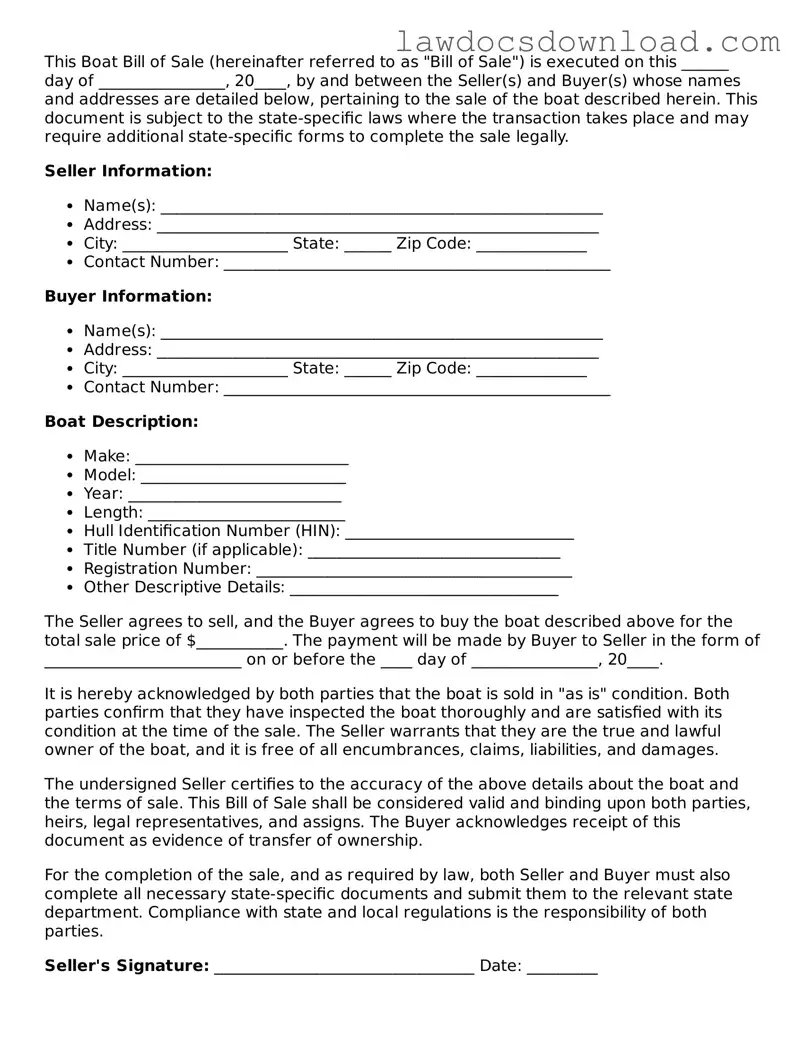The Vehicle Bill of Sale form bears a striking resemblance to the Boat Bill of Sale, as both serve as legally binding documents that record the sale and transfer of ownership from one party to another. These documents are essential in transactions concerning motor vehicles and boats, respectively. They typically include details like the make, model, year, identification number of the vehicle or vessel, the agreed-upon sale price, and the personal information of the buyer and seller. Both forms often require notarization to validate the agreement fully.
A General Bill of Sale is another document that shares similarities with the Boat Bill of Sale, as it is used to transfer ownership of personal property from one person to another. Unlike the Boat Bill of Sale, which is specialized for watercraft transactions, the General Bill of Sale can cover a wide range of items including furniture, electronics, and even livestock. The main components—description of the item sold, sale amount, and parties' details—are present in both documents, underscoring their purpose in facilitating legal and formal sales transactions.
The Real Estate Purchase Agreement, while specifically tailored for the sale of real property, parallels the Boat Bill of Sale in its outline and intent. Both documents are pivotal at the closing of their respective sales, detailing the transaction specifics such as the purchase price, description of the property or vessel, and the names and signatures of both the buyer and seller. Their primary function is to ensure a mutual understanding and agreement on the terms of sale, even though they cater to different types of property.
A Firearm Bill of Sale closely aligns with the Boat Bill of Sale due to its specialized nature, focusing on the sale and transfer of ownership of firearms. Similar to the boat-specific form, this document includes detailed information on the item being sold (in this case, the make, model, and serial number of the firearm), alongside the sale price and participating parties' details. Both forms serve to protect the rights of the buyer and seller, creating a record of the transaction that can be useful for registration or licensing requirements.
Aircraft Bill of Sale shares common ground with the Boat Bill of Sale, considering both are utilized in the sale of specialized types of transport. These documents are necessary for registering the aircraft or boat with the appropriate federal agencies—Federal Aviation Administration for aircraft, and a State Department or Coast Guard for boats. They include vital information such as the identification numbers, a thorough description of the aircraft or boat, and details about the transaction, ensuring compliance with regulations.
The Business Bill of Sale is akin to the Boat Bill of Sale as both are crucial in the transfer of ownership of assets. The Business Bill of Sale covers the sale of assets of a company, possibly including boats if they are part of the business' operational assets. While the scope might be broader with a business sale, encompassing inventory, goodwill, and other intangibles, the essence of documenting the sale price, description of assets being sold, and the parties involved mirrors the process of selling a boat.
An Equipment Bill of Sale, quite similar to the Boat Bill of Sale, is targeted at the sale of machinery or equipment. Whether selling a boat or a piece of construction equipment, these documents play a crucial role in detailing the transaction, including the condition, model, and unique identification numbers of the items being sold. Not merely facilitating the transfer of ownership, they also serve as proof of purchase and can be critical for warranty and service purposes.
The Promissory Note, while not a bill of sale, complements documents like the Boat Bill of Sale by detailing a promise to pay a specified amount of money, often related to the sale. In boat transactions, a Promissory Note might outline the buyer's agreement to pay the remaining amount owed after a down payment. It specifies the repayment schedule, interest rate, and consequences of non-payment, ensuring that financial agreements are clear and enforceable.
The Warranty Deed is primarily used in real estate but shares a conceptual similarity with the Boat Bill of Sale because it guarantees the buyer's ownership rights. While one deals with property and the other with boats, both assert that the seller holds the title to the item being sold and has the right to sell it. Importantly, they offer protection to the buyer, assuring them of the item’s or property's free and clear ownership transfer from any claims or liens.
Lastly, the Petition for Name Change document, though fundamentally different in purpose, involves a formal process much like the Boat Bill of Sale does for owning a boat. This document initiates a legal procedure for a person to change their name, requiring approval by a court, similar to how a Boat Bill of Sale requires notarization and sometimes registration with a government body to finalize the sale and transfer of ownership. Both processes formalize a change in status or ownership through legal documentation.
